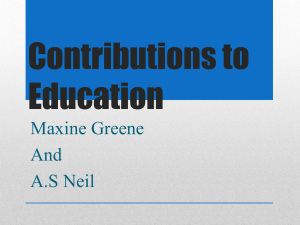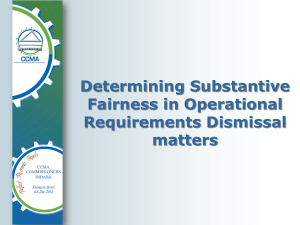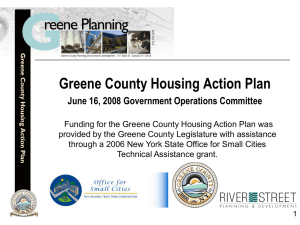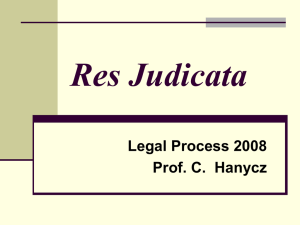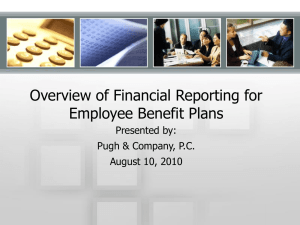The “At Will” Default Rule and Its Limits
advertisement
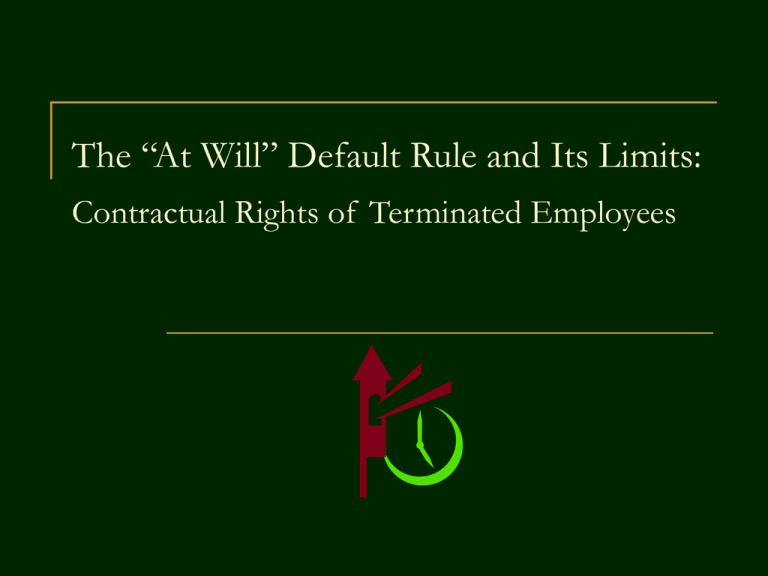
The “At Will” Default Rule and Its Limits: Contractual Rights of Terminated Employees Job Security and At-Will Employment Default rule: employment “at will” Employer free to fire Employee free to quit "The law, in its majestic equality, forbids the rich as well as the poor to sleep under bridges, to beg in the streets, and to steal bread.” Is the default rule based on: Parties’ intent? Social policy? Economic efficiency? Hanson v. Central Show Printing Co. Hanson, a longtime employee of Δ, offered a job from competitor. Δ: “I will guarantee you 40 hours work per week thru out the entire year each year until you retire of your own choosing.” π turned down competing offer. 2 years later, π fired without cause. Hanson (cont.) “Additional consideration” needed to depart from the default rule? “additional” to what? Inquiry into “adequacy of consideration”? Revival of “mutuality” of obligation? Either riff on consideration doctrine reveals s great deference to at-will presumption Twisting of normal contract doctrine To what end? Hanson Notes: “At will” theoretically a default rule parties may vary But how easy to opt out? “Permanent” or lifetime” employment is often construed by courts as at will Too indefinite? Policy against such long-term commitments? Are court seeking party intent or something else? The origins of the at-will rule Horace G. Wood, Master & Servant § 134 (1877) Not so well-founded in the cases cited? Why did it so quickly become law in the U.S? Greene v. Oliver Realty Inc. 1959: Greene agrees to work for Grant Building below scale in exchange for “lifetime” work 1975: Grant Building taken over by Oliver 1975: Oliver promises to honor Grant’s obligations 1983: Greene laid off 24 years after original promise 8 years after the new president’s assurance Greene, needless to say, still alive! Greene (cont.) Rationales for “at will” presumption 1. 2. 3. 4. 5. Freedom of contract Mutuality of obligation Expectation of “at will” employment Juries too sympathetic to promises of lifetime employment Employers lack remedy against employees breaching lifetime contracts. Greene (cont.) “Totality of the circumstances” test For whether the default rule has been varied Additional consideration one factor in totality test “Casual aside”? “Purely aspirational”? No intent to contract? Isn’t this always an inquiry in Contracts cases? What is the court looking for in this totality search? Greene Notes: Is “at will” what most parties expect? The law because it’s what’s expected? Or it’s expected because it’s the law? Contrary presumption under Montana Wrongful Discharge Act Model Employment Termination Act. Only Montana has switched the default Is at will a response to agency problems? Employer agents over-promising? Successor liability restricts firm marketability? More Greene Notes: More on jury biases Is it true? If true, is it appropriate consideration? Revisiting mutuality Unilateral contract theory How significant the “presumption”? Extracorporeal : “permanent” too broad to be enforced? What would work? Are Hanson and Greene so different? Problem 2-1 Oral/Implied Contract Rights to Job Security Roadmap: Reliance on offers of employment: = “front end” of employment relationship Assurances of continued employment = “back end” of employment relationship Written manuals, handbooks, policies: anywhere during an ongoing relationship Reliance on Offers of Employment Grouse v. Group Health Plan: Employee has right to “good faith opportunity to perform his duties to the satisfaction” of the employer after starting work Relief may be limited to reliance damages Expectation is salary from new employer How long? Is reliance the lost job from the prior employer? How long? Goff-Hamel v. Obstetricians & Gynecologists Goff-Hamel had left her employer of 11 years based on Δ’s offer of employment 2 months after she accepted the offer, and one day before she was to start, Δ told her not to report to work No contract claim Promissory estoppel lies Dissent finds result inconsistent with at will doctrine Goff-Hamel Notes “Good faith opportunity to perform” One day not enough One month? Is it reasonable to rely? Party actual expectations v. legal entitlements What constitutes reliance? Quitting prior job Relocating Anything else? Proof that the action taken was really in reliance on the promise Schoff v. Combined Insurance Co. of America Schoff gave up a 16 year position to accept an offer as a Δ’s sales representative Δ terminated Schoff for Schoff must show “clear and definite promise” failure to disclose his criminal record failure to get bonded That bonding wasn’t necessary or That felonies/nondisclosure wouldn’t bar bond How likely is that? Schoff Notes Distinction between promises and representations Possible statutory protection for arrest/conviction records Robert Hillman’s study suggest promissory estoppel more viable in the classroom than the courtroom Assurances of Continued Employment Long-term employees have incentives to sue Shebar v. Sanya: oral contract Pugh v. See’s Candies: implied contract Shebar v. Sanyo Business Systems Corp. Shebar, national sales manager for Sanyo, obtained an offer from Sony Sanyo’s president’s assured π of employment for life with a large raise soon Shebar then turned Sony down 3 months later, Shebar fired without cause Shebar (cont.) True lifetime employment is extraordinary, requiring clear and convincing proof “Plaintiff acted in reliance on the alleged promise by forgoing the job opportunity he had secured at Sony.” This was the extra consideration needed for a claim Shebar Notes Contract or estoppel? Life time employment v. for cause protection Statute of frauds for oral promises Shebar a slam-dunk on remand? Racial and ethnic themes Can culture + workplace practices create contractual rights? Pugh v. See’s Candies, Inc. Pugh worked for See’s Candies for 32 years From dishwasher to Vice President 1973: π terminated without explanation Pugh (cont.) At-will presumption overcome by evidence of express or implied agreement All circumstances bearing on implied agreement should be examined “Independent consideration” serves only “evidentiary function” π prima facie case of breach of contract shift burden to the employer to show sufficient reason Ultimately π lost on sufficient reason Pugh Notes Are some seemingly employee-friendly decisions ultimately of little value to workers? Should expectations of job security translate into obligations of the employer? Must the employer foster them? Must they be reasonable? Can they be reasonable in light of at will rule? Guz v. Bechtel Consistent with Pugh, or a retreat? “Life cycle justice” per Dean Schwab Problem 2-2 Promissory Estoppel? Oral Contract? Implied-in-Fact Contract? Problem 2-3 Risk Management Written Employment Manuals and Policies Employment Manuals Promise of job security Disclaimers Modification Woolley v. Hoffman-La Roche, Inc. 1969: π hired as engineering section head 1969: π received personnel manual: “It is the policy of Hoffmann-La Roche to retain to the extent consistent with company requirements, the services of all employees who perform their duties efficiently and effectively” 6 types of terminations specified: layoff, discharge due to performance, discharge disciplinary, retirement and resignation. 9 years later π was fired after writing a report on a piping problem Woolley (cont.) Manual should be “construed in accordance with reasonable expectations of employees” Manual = offer of unilateral contract Continued employment = acceptance Employers can avoid words of commitment And/or insert disclaimers in personnel materials. Woolley Notes Contract interpretation or broader policies? But is at will merely interpretive? “Legalizing” of personnel policy a reaction to unions? Are relational norms morphing into contractual commitments? Should they? Conner v. City of Forest Acres 1984-1993: Conner police dispatcher for City 1993: π terminated Π reprimanded and given 90-day probation Grievance committee voted to reinstate π City Council rejected that decision Conner (cont.) Jury question whether handbook created contractual rights despite disclaiming language City can’t have its cake and eat it too Words of promise must be avoided even if disclaimers/acknowledgments used If π had rights, Δ must have a “reasonable good faith belief” in sufficient cause N.B. Employer need not be correct Difference between grievance committee and City Council might bar summary judgment Conner Notes Effective disclaimers should be clear and conspicuous language Even well-drafted disclaimer might not trump words of promise Can an employer violate its procedures for termination even when sufficient reason exists? What’s the appropriate remedy? Problem 2-4 Limiting language of commitment Adding a disclaimer Demasse v. ITT Corporation 1989: Employer modified handbook to add: An “at will provision” A clause permitting unilateral modification 1993: Δ announced layoff would be based on performance, not seniority What inspired the 1989 change? What inspired the 1993 change? Demasse (cont.) Certified question: whether the employer can unilaterally change seniority policy, assuming it was contractually binding to begin with? Majority finds in favor of the workers Workers’ consent necessary Offer/acceptance/consideration Dissent: strongly influenced by desire to preserve managerial flexibility Demasse Notes “Separate” consideration requirement Is majority resurrecting a dead concept to protect workers? How to advise corporate clients in the face of legal uncertainty? Is contract really the appropriate framework for assessing enforceability of handbooks? Problem 2-5 Applying Demasse to Asmus




